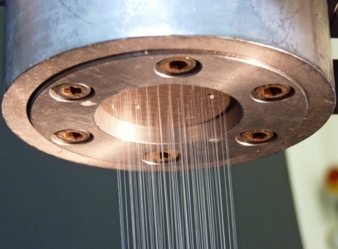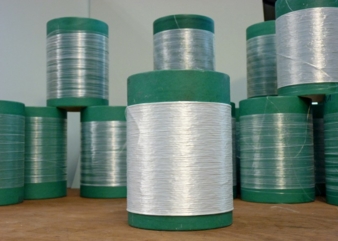21/08/2015 — auf Deutsch lesen
CMCs set the standard
One moment red-hot – the next, suddenly chilled. Extraordinary stresses such as these are conditions that very few materials, especially when also under mechanical strain, can tolerate. Yet there are many technical applications that make precisely such demands of materials. Technical ceramics are at the heart of this: it is possible to combine their ability to withstand heat with certain additional properties.
CMCs represent a specific class of such materials. These 'ceramic matrix composites', as they are known, consist of ceramic fibres embedded in a ceramic matrix. The fibres in the structure dissipate tensile forces. This makes the material extraordinarily robust – it exhibits none of the typical brittle fracturing behaviour familiar in conventional ceramics. CMCs are resistant to thermal shock and have a long-term stability even under high temperatures and stresses.
CMCs are not easy to manufacture. Even the technical process of turning ceramic fibres into woven fabrics, which as a rule is an interim stage in the production of CMCs, is a demanding one: despite their high degree of tensile strength, the fibres have little in the way of shearing resistance. The fragile fibres are therefore easily broken during the weaving process.
This is being tackled at ITCF Denkendorf with a group of materials that is new to fibre manufacturing, namely a particular form of mixed oxide ceramics. In terms of the crucial physical properties – resistance to bending fractures and resistance to cracking ('fracture strength') – they achieve significantly better performance values.
The mixed oxide ceramic material consists of aluminium oxide (Al2O3) and zirconium oxide (ZrO2). These zirconia-toughened alumina, or ZTA, ceramics stand apart from pure oxide ceramics with better mechanical properties: what is more, they can be further refined by adjusting the proportions of the individual substances in the mix.
Although ZTA ceramics are already making their mark in the industrial production of parts for specialised tools, medical engineering applications and insulating components, their application in the production of ceramic fibres is still largely unknown territory. Manufacturing the fibres relies on a sol-gel process in which a textile pulp is produced from basic aluminium chloride and zirconium chloride, using water as the solvent.
Initial laboratory trials have produced fibres with mean strength factors way in excess of what had been expected at this early stage of development.





